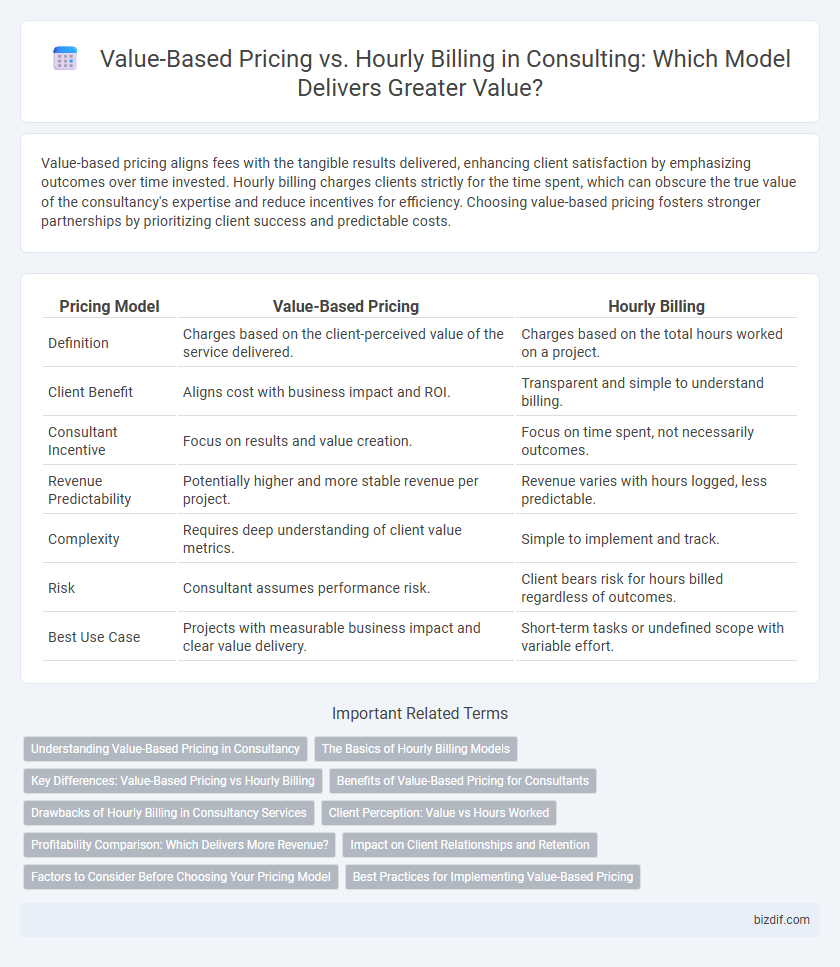Value-based pricing aligns fees with the tangible results delivered, enhancing client satisfaction by emphasizing outcomes over time invested. Hourly billing charges clients strictly for the time spent, which can obscure the true value of the consultancy's expertise and reduce incentives for efficiency. Choosing value-based pricing fosters stronger partnerships by prioritizing client success and predictable costs.
Table of Comparison
| Pricing Model | Value-Based Pricing | Hourly Billing |
|---|---|---|
| Definition | Charges based on the client-perceived value of the service delivered. | Charges based on the total hours worked on a project. |
| Client Benefit | Aligns cost with business impact and ROI. | Transparent and simple to understand billing. |
| Consultant Incentive | Focus on results and value creation. | Focus on time spent, not necessarily outcomes. |
| Revenue Predictability | Potentially higher and more stable revenue per project. | Revenue varies with hours logged, less predictable. |
| Complexity | Requires deep understanding of client value metrics. | Simple to implement and track. |
| Risk | Consultant assumes performance risk. | Client bears risk for hours billed regardless of outcomes. |
| Best Use Case | Projects with measurable business impact and clear value delivery. | Short-term tasks or undefined scope with variable effort. |
Understanding Value-Based Pricing in Consultancy
Value-based pricing in consultancy revolves around setting fees based on the delivered business outcomes and perceived client value rather than the time spent on a project. This approach aligns consultant incentives with client success, often leading to higher profitability and stronger client relationships. Key metrics for value-based pricing include return on investment (ROI), cost savings, and strategic impact, shifting focus from hours billed to measurable value generated.
The Basics of Hourly Billing Models
Hourly billing models charge clients based on the actual time consultants spend on a project, typically measured in hours or fractions thereof. This approach provides transparency and flexibility but can incentivize longer project durations rather than efficiency. Many consulting firms use timesheets to track hours and ensure accurate client invoicing under this traditional pricing structure.
Key Differences: Value-Based Pricing vs Hourly Billing
Value-Based Pricing charges clients based on the perceived value and outcomes delivered, emphasizing results and client benefits rather than time spent. Hourly Billing calculates fees strictly by the number of hours worked, which may not account for the overall impact or success of the project. This key difference shifts the financial focus from effort measurement in Hourly Billing to outcome-driven rewards in Value-Based Pricing, aligning consultant incentives with client goals.
Benefits of Value-Based Pricing for Consultants
Value-based pricing enables consultants to align fees with the perceived value delivered to clients, fostering stronger client relationships and higher satisfaction. This approach drives increased profitability by incentivizing efficiency and innovation, rather than simply logging hours. Consultants gain competitive differentiation and improved cash flow predictability through transparent value delivery and outcome-focused engagements.
Drawbacks of Hourly Billing in Consultancy Services
Hourly billing often leads to inefficiencies in consultancy services by incentivizing longer project durations rather than delivering value-driven outcomes. This approach can create budget unpredictability for clients, undermining trust and satisfaction. Moreover, it fails to align consultant incentives with client success, potentially limiting innovation and strategic problem-solving.
Client Perception: Value vs Hours Worked
Value-based pricing appeals to clients by emphasizing outcomes and measurable benefits rather than the time spent on tasks, fostering a perception of fairness and alignment with their goals. This approach often enhances client trust as they associate costs directly with delivered value, not merely hours logged. In contrast, hourly billing can create client uncertainty about efficiency since payments correlate solely with time, potentially detracting from perceived value.
Profitability Comparison: Which Delivers More Revenue?
Value-based pricing often generates higher profitability by aligning fees with client-perceived value rather than time spent, enabling consultants to capture premium rates for impactful outcomes. Hourly billing limits revenue growth as it caps earnings to the number of hours worked, regardless of the actual value delivered to clients. Studies show top-performing consultancies increase revenue by up to 30% when shifting from hourly billing to value-based pricing models.
Impact on Client Relationships and Retention
Value-based pricing enhances client relationships by aligning fees with the delivered value, fostering trust and long-term commitment. Hourly billing may create tension due to perceived inefficiencies, potentially undermining client satisfaction and retention. Consultants adopting value-based pricing often experience higher client loyalty and more collaborative partnerships.
Factors to Consider Before Choosing Your Pricing Model
Evaluate client project scope and complexity to determine whether value-based pricing maximizes profit by aligning fees with results, or hourly billing ensures transparent compensation for time spent. Assess market demand, competitor pricing, and client budget flexibility to select a model that supports sustainable growth and client satisfaction. Consider administrative overhead and risk tolerance since value-based pricing requires robust outcome measurement while hourly billing offers straightforward invoicing.
Best Practices for Implementing Value-Based Pricing
Implementing value-based pricing requires a deep understanding of client goals and the measurable outcomes your consultancy delivers, aligning fees with the value created rather than hours worked. Establish clear communication strategies and transparent pricing models to build trust and demonstrate the ROI clients receive, fostering long-term partnerships. Utilize data analytics and client feedback to continuously refine pricing structures, ensuring they reflect market demand and strategic value effectively.
Value-Based Pricing vs Hourly Billing Infographic

 bizdif.com
bizdif.com